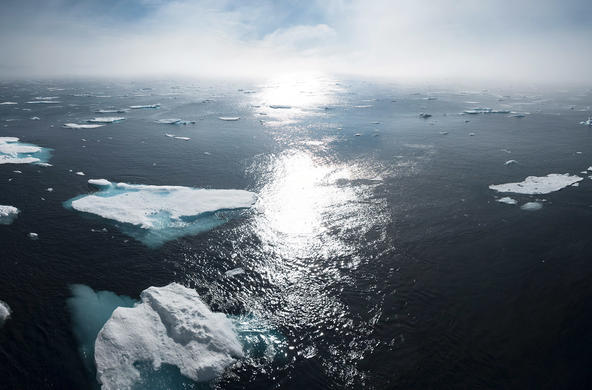The Gulf of Mexico is home to a dead zone roughly the size of New Jersey. Inhospitable waters are caused by excess nitrogen that originates from distant Mid-western agribusinesses. Fertilizer makes its way down the Mississippi River and into the Gulf, stimulating algal blooms. When algae decompose, they strip oxygen from the water, creating conditions that threaten important fisheries.
This is one example of what scientists refer to as a coupled biogeochemical cycle. In this case, human inputs to the nitrogen cycle—applying fertilizer to crops—results in a disruption to the oxygen cycle of coastal waters. Understand- ing how biogeochemical cycles interact is at the heart of solving many of society’s most pressing environmental issues, including global climate change. The Cary Institute is playing a leadership role in advancing this emerging discipline.
At the Ecological Society of America’s (ESA) annual meeting in August, Cary Institute biogeochemist Dr. Jonathan J. Cole co-organized a set of four special sessions on the topic with colleagues Dr. Adrien Finzi of Boston University and Dr. Elisabeth Holland of the National Center for Atmospheric Research. Made possible by $185,000 in National Science Foundation funding, the sessions convened a group of 50 speakers and invitees. In addition to Cole, Cary Institute presenters included president Dr. William H. Schlesinger, Dr. Gene E. Likens, and Dr. Amy J. Burgin.
With over 400 ESA members attending each of the sessions, the event encouraged dialogue among scientists from diverse fields. In addition to ecologists, physical scientists, atmospheric scientists, and oceanographers were well represented as both presenters and participants. Cole commented, “When people from different disciplines realize they have goals and approaches in common, it can be a catalyst for scientific progress.”
Historically, scientists have focused on specific chemical cycles, such as the carbon cycle or the nitrogen cycle. But biogeochemical cycles do not exist in isolation—they are coupled to each other and to physical features of the Earth. Cole notes, “Seemingly subtle chemical changes can have large environmental effects. Consider that climate change is caused by increases in carbon dioxide and methane—gases which occupy less than 1⁄2 of 1% of the atmosphere.”
Climate change models were identified as an area that would benefit from further coupled biogeochemical research. Most of us are aware that when burned, fossil fuels release carbon dioxide and that in the atmosphere, excess carbon dioxide drives climate change. But this is only part of the story.
During photosynthesis, plants use carbon dioxide to build new organic matter (i.e. leaves and wood). When plants grow, they can remove carbon dioxide from the atmosphere. Properly accounting for how much carbon dioxide plants will sequester in a carbon-elevated future requires insight into how plant growth is coupled to both the nitrogen and the water cycle.
In addition to strengthening climate change models, a better understanding of coupled biogeochemical cycles will help guide more effective wetland restoration, emission regulations, and fisheries management. Proceedings of the ESA session will be published in an upcoming edition of Frontiers in Ecology and the Environment. Conversations started at the event will help foster future collaborations.
This is one example of what scientists refer to as a coupled biogeochemical cycle. In this case, human inputs to the nitrogen cycle—applying fertilizer to crops—results in a disruption to the oxygen cycle of coastal waters. Understand- ing how biogeochemical cycles interact is at the heart of solving many of society’s most pressing environmental issues, including global climate change. The Cary Institute is playing a leadership role in advancing this emerging discipline.
At the Ecological Society of America’s (ESA) annual meeting in August, Cary Institute biogeochemist Dr. Jonathan J. Cole co-organized a set of four special sessions on the topic with colleagues Dr. Adrien Finzi of Boston University and Dr. Elisabeth Holland of the National Center for Atmospheric Research. Made possible by $185,000 in National Science Foundation funding, the sessions convened a group of 50 speakers and invitees. In addition to Cole, Cary Institute presenters included president Dr. William H. Schlesinger, Dr. Gene E. Likens, and Dr. Amy J. Burgin.
With over 400 ESA members attending each of the sessions, the event encouraged dialogue among scientists from diverse fields. In addition to ecologists, physical scientists, atmospheric scientists, and oceanographers were well represented as both presenters and participants. Cole commented, “When people from different disciplines realize they have goals and approaches in common, it can be a catalyst for scientific progress.”
Historically, scientists have focused on specific chemical cycles, such as the carbon cycle or the nitrogen cycle. But biogeochemical cycles do not exist in isolation—they are coupled to each other and to physical features of the Earth. Cole notes, “Seemingly subtle chemical changes can have large environmental effects. Consider that climate change is caused by increases in carbon dioxide and methane—gases which occupy less than 1⁄2 of 1% of the atmosphere.”
Climate change models were identified as an area that would benefit from further coupled biogeochemical research. Most of us are aware that when burned, fossil fuels release carbon dioxide and that in the atmosphere, excess carbon dioxide drives climate change. But this is only part of the story.
During photosynthesis, plants use carbon dioxide to build new organic matter (i.e. leaves and wood). When plants grow, they can remove carbon dioxide from the atmosphere. Properly accounting for how much carbon dioxide plants will sequester in a carbon-elevated future requires insight into how plant growth is coupled to both the nitrogen and the water cycle.
In addition to strengthening climate change models, a better understanding of coupled biogeochemical cycles will help guide more effective wetland restoration, emission regulations, and fisheries management. Proceedings of the ESA session will be published in an upcoming edition of Frontiers in Ecology and the Environment. Conversations started at the event will help foster future collaborations.






